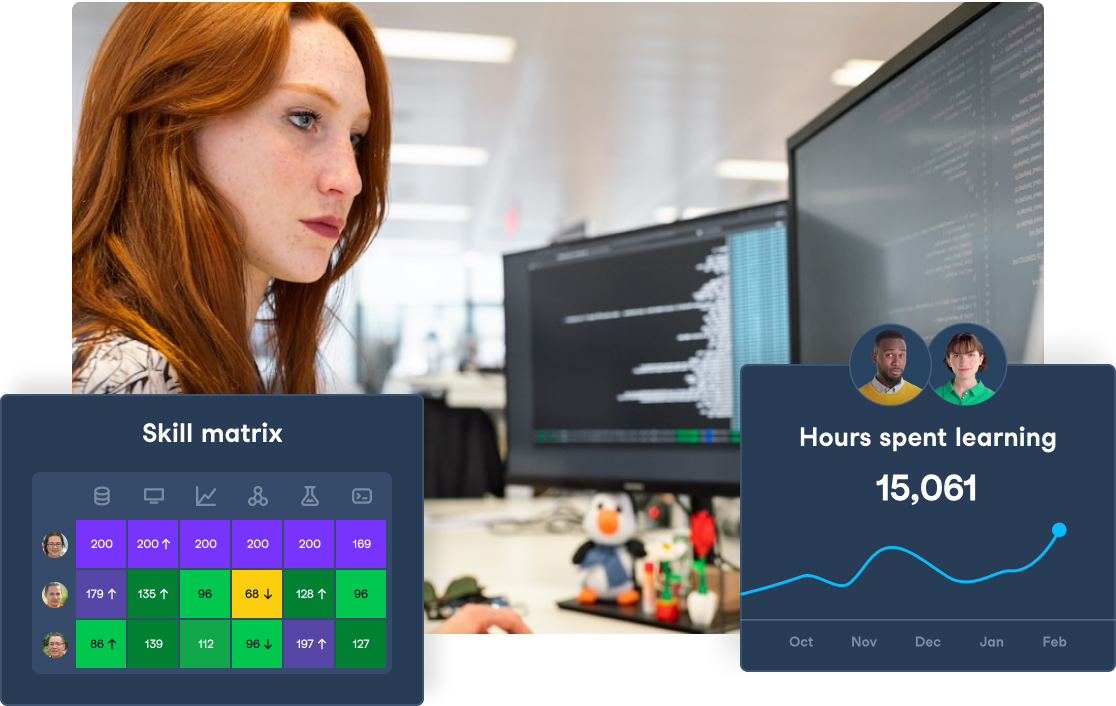Track
Generative AI is rapidly changing the world. Since the launch of ChatGPT in 2022, the number of AI applications hasn’t ceased to increase. As a result of the massive adoption of these tools, many social and economic activities, including education, are likely to experience deep changes.
With its powerful capabilities, generative AI is set to revolutionize how we teach and learn. However, like any other cutting-edge technology, the potential benefits come with challenges and risks. What does generative AI mean for educators, students, and the broader educational environment? How will education be conceived and conducted in the coming future?
This article aims to address some of these questions. We will explore the effective and ineffective uses of generative AI in the classroom. With educators in mind, we will also offer practical tips for using AI in education settings. Finally, we will examine the social and ethical implications of the adoption of generative AI in education and how to address these concerns.
Get your Free DataCamp Classroom Now
"Whether you’re teaching a pure data science class or something more multidisciplinary, DataCamp Classrooms is a tool every teacher and student should use.” — Mike Soltys, PhD. University of Colorado Boulder

Understanding Generative AI
Generative AI is a field of artificial intelligence that focuses on systems capable of generating new content, such as images, text, and audio, that mimic human creativity.
Unlike other forms of AI, such as machine learning, which focuses on analyzing and making predictions based on existing data, generative AI creates new content from scratch.
Popular generative AI tools, like ChatGPT, Google Gemini, and DALL-E, are based on powerful large language models (LLMs). LLMs rely on an innovative neural network called a transformer that can produce accurate content based on a given input.
To deliver their magic, these models are usually trained with massive amounts of data, the Internet being the primary source.
Check out our Large Language Models (LLMs) Concepts Course to learn the technologies behind generative AI models and discover their full potential.
Generative AI is rapidly changing education, a sector that is constantly evolving and moving beyond the walls of traditional classrooms. Public authorities have traditionally been enthusiastic about new technologies, which are regarded as powerful drivers of improvement in the way we teach and learn.
Given the enormous potential of generative AI, it’s not surprising that governments and education institutions across the globe are already testing the possibilities of these tools in all kinds of educational scenarios.
However, generative AI is in a nascent stage, and it won’t deliver its promises immediately. Also, given the different needs and resources of educational institutions, it will be important for these actors to identify areas where generative AI can have the most significant impact.
Good Uses of Generative AI in Education
As we will see in the following paragraphs, AI's potential in education extends beyond its technological capabilities. It has the power to make education more accessible, engaging, and customized to students’ needs, as well as to make education administrations more efficient and productive.
Let’s analyze the most compelling benefits of generative AI.
Personalized learning
It is widely accepted that adapting the teaching and learning process to each student's characteristics, needs, and interests is important to improving their motivation, engagement, understanding, and academic performance.
However, advancing personalized learning is one of the most significant challenges in education. Even in countries at the forefront of education, classrooms are so big that educators don’t have the time to focus on every student’s needs. Equally, education materials typically follow a one-size-fits-all fashion, which often fails to engage part of the students.
Against this backdrop, generative AI is regarded as a pivotal technology that enables personalized learning. By analyzing huge amounts of student data, generative AI tools can identify student’s strengths and weaknesses, creating new personalized content and assignments to meet their individual needs.
This information is valuable not only for AI assistants to create tailored content but also for educators, who can identify students' potential struggles and thereby help them design their lessons.
Enhanced engagement
Closely related to the previous section, generative AI can also be an effective technology to enhance student engagement. Every student is different, and the traditional one-size-fits-all curriculum may not suit some. It’s not only about their level but also about their preferences and learning styles.
With generative AI, students could ideally get precisely what they need to enjoy the day in the classroom and increase their engagement—videos and images instead of text, practice instead of theory, and quizzes instead of long assignments. The possibilities are endless.
Education for everyone
Generative AI has the potential to democratize education, making learning opportunities accessible to students who would otherwise encounter obstacles.
AI can be particularly effective in highly diverse classrooms with students of different backgrounds, economic status, and languages. By assisting educators in providing personalized, adaptive learning experiences to all students, generative AI can be central to fostering an inclusive and accessible learning environment.
Administrative efficiency
The daily life of educators expands beyond teaching. It also involves many administrative, time-and-energy-consuming tasks, including grading assignments and exams, preparing materials and lessons, filling forms, and writing reports.
Generative AI can streamline and speed up some of these tasks, allowing teachers to work less and devote more attention to students' needs.
Supporting creativity and critical thinking
Generative AI can be a valuable tool for enhancing students’ potential. By creating complex, unconventional scenarios in all kinds of disciplines (from math and history to arts and music), generative AI can challenge student’s existing perspectives, prompting them to think critically to solve these problems.
For creativity, generative AI tools can work as effective assistants in tasks like story drafting and image, video, or music generation. If used wisely, they are particularly suitable to boost intellectual creativity, help students at the beginning of their journey in a certain discipline, and overcome obstacles during creative processes, like mental blocks.
|
Category |
Description |
Example applications |
|
Personalized learning |
Adapts content to individual student's needs, strengths, and weaknesses. |
Tailored lesson plans, individualized assignments, custom quizzes |
|
Enhanced engagement |
Increases student engagement by catering to different learning styles and preferences. |
Interactive videos, gamified learning experiences, adaptive assessments |
|
Education for everyone |
Democratizes education by providing adaptive learning experiences for diverse classrooms. |
Multilingual support, accessibility tools for students with disabilities |
|
Administrative efficiency |
Streamlines administrative tasks, freeing up educators to focus on teaching. |
Automated grading, lesson planning, and report generation |
|
Supporting creativity |
Assists in creative tasks, helping students overcome blocks and explore new ideas. |
AI-driven story generation, art creation, and music composition |
Good uses of generative AI in education: A summary
Your Introduction to ChatGPT
Bad Uses of Generative AI in Education
Like all beneficial technologies, generative AI also has its fair share of limitations, challenges, and potential for misuse. Let’s examine them in close detail.
Over-reliance
One of the main concerns about the adoption of generative AI is the risk of becoming too dependent on this technology. In essence, it’s the same debate as whether or to what extent calculators, computers, or smartphones should be allowed in the classroom.
Technology makes our lives easier. It can perform tasks in seconds that would take minutes, hours, or even days. In the case of generative AI, the number of use cases in educational settings is potentially unlimited, from writing essays and preparing presentations to summarizing readings and completing assignments.
Yet, suppose we let technology do everything for students. In that case, we risk losing the endeavor, frustration, and fulfillment that are an intrinsic part of any learning process and replacing them with a lack of decision-making, laziness, and frustration.
Misinformation and bias
Despite their impressive capabilities, generative AI models don’t really understand the meaning of the language they process. They are just making complex calculations to create accurate content based on the data they have been trained with.
As a result, these models are prone to producing responses that are either factually incorrect, nonsensical, or even harmful, commonly known as LLM hallucinations. In other cases, generative AI models can be biased, resulting in unfair, discriminatory, and stereotypically generated content, particularly against minority groups.
If students (or even instructors) cannot identify inaccurate content, this could spark misinformation and discriminatory beliefs in the classroom.
Loss of human interaction
Education is the process of learning new knowledge and skills. Rather than individual, this is a collective process, especially in early childhood.
The classroom is the preferred setting for education because it fosters interaction among students, who spend considerable time not only learning and working together but also getting to know each other, gossiping, and making friendships. The same applies to the student-teacher relationship, a bond based on trust and respect that is crucial for learning.
Generative AI promises a more effective, personalized education. But this also could result in a more solitary, isolated education, as students would spend part of their time interacting with a virtual assistant instead of their educators and peers, which could jeopardize their social skills.
Academic integrity
Academic integrity means being honest, fair, respectful, and responsible in your studies and academic work. Following the rise of generative AI, ensuring academic integrity has become challenging.
As already mentioned, generative AI is a new technology. There are still many uncertainties about how to regulate it, including in educational settings. As a result, academic institutions and education hardly ever have clear guidelines on the limitations and expectations for the use of generative AI.
Generative AI increases the risk that students may use it to submit work that is not their own. Addressing these risks is particularly difficult, as current technologies that detect AI-generated content are not accurate and reliable enough, which could result in unfair accusations of improper use of AI.
|
Category |
Description |
Potential consequences |
|
Over-reliance |
Dependence on AI for tasks that students should learn to perform themselves. |
Reduced problem-solving skills, lack of critical thinking |
|
Misinformation and bias |
Risk of AI generating incorrect, biased, or harmful content. |
Spread of misinformation, perpetuation of stereotypes |
|
Loss of human interaction |
Reduced opportunities for social learning and relationship building. |
Weakened social skills, isolation |
|
Academic integrity |
Challenges in ensuring students submit original work. |
Increase in plagiarism, difficulty in assessing true understanding |
|
Digital divide |
Inequitable access to AI tools among students of different socioeconomic backgrounds. |
Widening educational inequalities |
Challenges of generative AI in education: A summary
Practical Tips for Using AI in Education
If you are considering using generative AI tools in your daily work and introducing them to your students, you should consider the following practical tips:
Identify successful use cases
Given the powerful capabilities of generative AI, the number of use cases is potentially unlimited. While innovation in the classroom is always welcome, you should always be mindful of the challenges and limitations of using generative AI in your course.
Fortunately, the research on the impact of generative AI in education is rapidly evolving. Conducting preliminary research is key to identifying successful use cases and anticipating potential pitfalls.
Just to give you a glimpse of the possibilities of generative AI in education, here is a list with some promising use cases:
- Developing critical thinking
- Creative writing and visualization
- Comparative analysis
- Language learning
- Historical role-play
Set clear guidelines
Before introducing generative AI in the classroom, you should be fully aware of its capabilities and limitations. In this research phase, you should also check whether the technology aligns with your educational institution’s values, missions, and rules and how it can create added value in your course.
Only then will you be ready to introduce generative AI to your students. Transparency is important here to ensure everyone is on the same page. State clearly the course’s generative AI policies, identifying situations where the use of generative AI is prohibited.
When generative AI is allowed, you should explain how to document and credit content, providing recommendations and examples. These rules in terms of documentation and attribution should also apply to you if you use generative AI during the preparation of your materials.
Monitor the tool
Generative AI is a powerful technology, but it is not bulletproof. It can be subject to hallucinations, or it simply may not work as you expected.
Ideally, you should have control over what your students see on their screens. However, this may not be technologically feasible in every scenario, and it could raise concerns about students' privacy.
Given the current state of generative AI, establishing trusting relationships with students and designing clear guidelines and policies is probably the most effective strategy to ensure correct use.
Generative AI Ethical Considerations and Best Practices
As always occurs with emerging technologies, with power comes responsibility. Despite generative AI's unique capabilities, it’s important to consider its potential risks and ethical considerations.
- Privacy and data security. Generative AI models are trained with vast amounts of data extracted indiscriminately from the Internet, which often contains personal data. This can lead to issues and risks related to data privacy and security, especially if sensitive personal data are disclosed.
- Transparency and attribution. GenAI systems are black boxes in nature, which implies that it is difficult to understand how they arrived at a particular response or what factors led to their decision-making. In the context of education, this can lead to serious problems of attribution, as instructors won’t be able to know who is the author of a given work, whether the student or generative AI.
- Addressing bias and accuracy. Biased GenAI tools can result in harmful outputs that often exacerbate discrimination and stereotypes, particularly against minority groups. AI researchers are working hard to address bias and improve the accuracy of generative AI models. Check out the Understanding and Mitigating Bias in Large Language Models to learn more about the subject.
- Digital divide. If wrongly implemented, generative AI threatens to widen the digital divide. On the one hand, if generative AI is set to become ubiquitous, every student should have equal access to this technology, meaning that all of them should have a digital device and internet connection. However, this is not the case. A possible solution would be to entrust educational institutions to provide equal access, but this would require considerable resources that many centers, especially in poor areas, don’t have. This is a critical concern that should be addressed carefully. Otherwise, we risk widening the distance between the poor and the rich.
Conclusion
Generative AI is here to stay and has the potential to revolutionize every sector of the economy, including education. It’s up to educators and ed-tech solution providers to determine the most effective way to tap into the technology’s potential while mitigating its potential risks.
DataCamp is working hard to provide comprehensive and accessible resources for educators to keep updated with AI development. Check them out:
Elevate Your Organization's AI Skills
Transform your business by empowering your teams with advanced AI skills through DataCamp for Business. Achieve better insights and efficiency.

FAQs
What are the main benefits of using generative AI in education?
Some of the most compelling benefits of generative AI in education are: personalized learning, increased student engagement and accessibility, administrative efficiency, and increased creativity and critical thinking skills.
What are the main challenges of using generative AI in education?
Gen AI also comes with important challenges in the field of education, including technology over-reliance, misinformation, loss of human interaction, and problems of academic integrity.
What ethical concerns are associated with using AI in education?
The main ethical considerations related to implementing generative AI are privacy and data security, transparency and attribution, bias and accuracy, and unequal access to generative AI tools.
What practical tips should be considered when using AI in education?
Before deploying GenAI tools in your class, you should identify successful use cases and set transparent guidelines for generative AI. Once implemented, find your way to keep control of how generative AI is being used.
How can I prepare for the generative AI revolution as a docent?
DataCamp is working hard to provide comprehensive and accessible resources for educators to keep updated with AI development.

I am a freelance data analyst, collaborating with companies and organisations worldwide in data science projects. I am also a data science instructor with 2+ experience. I regularly write data-science-related articles in English and Spanish, some of which have been published on established websites such as DataCamp, Towards Data Science and Analytics Vidhya As a data scientist with a background in political science and law, my goal is to work at the interplay of public policy, law and technology, leveraging the power of ideas to advance innovative solutions and narratives that can help us address urgent challenges, namely the climate crisis. I consider myself a self-taught person, a constant learner, and a firm supporter of multidisciplinary. It is never too late to learn new things.


